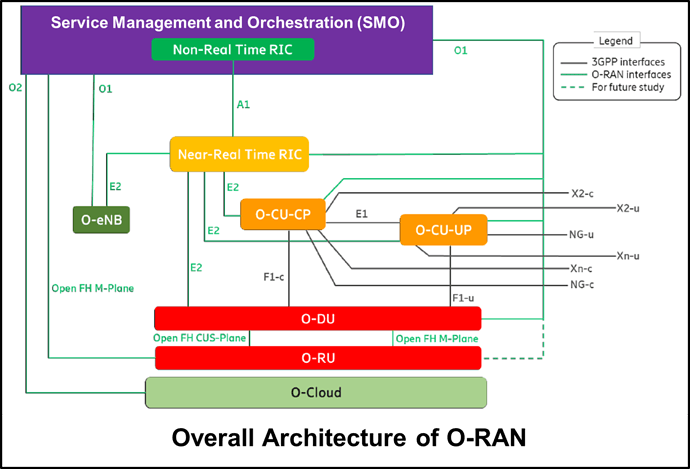-
My friend: Hi Ibrahim, I have a question for you.
- Me: Please, go ahead.
-
My friend: I was wondering if the O-RAN architecture specified by O-RAN Alliance is different from the architecture specified by 3GPP or not?
-
Me: This is really a good question
 . The below figure is showing the O-RAN architecture and it is clear that we have some differences from the 3GPP architecture and some similarities as well as O-RAN Alliance is trying to use the 3GPP architecture and even enhance it. So, for example, gNB-DU in 3GPP now became O-DU+O-RU in O-RAN and they are connected through the fronthaul interface using option 7.2x, gNB-CU in 3GPP is the same as O-CU in O-RAN and its split into O-CU-UP and O-CU-CP is already mentioned in the 3GPP specifications.
. The below figure is showing the O-RAN architecture and it is clear that we have some differences from the 3GPP architecture and some similarities as well as O-RAN Alliance is trying to use the 3GPP architecture and even enhance it. So, for example, gNB-DU in 3GPP now became O-DU+O-RU in O-RAN and they are connected through the fronthaul interface using option 7.2x, gNB-CU in 3GPP is the same as O-CU in O-RAN and its split into O-CU-UP and O-CU-CP is already mentioned in the 3GPP specifications.
-
Me: This is really a good question
-
My friend: So, what about the O-Cloud and SMO?
- Me: O-Cloud is the cloud platform which simply means the physical infrastructure like servers or COTS hardware that meet O-RAN requirements to host the relevant O-RAN functions (i.e., Near-RT RIC, O-CU-CP, O-CU-UP, and O-DU) as all these functions can be virtualized and deployed using software on this hardware which is the O-Cloud. And of course, you noticed that O-RU is not virtualized as its virtualization is for future study. While, SMO (Service Management and Orchestration) is responsible for RAN domain management such as O-Cloud Management, Orchestration and Workflow Management through O2 interface. Also, SMO is providing FCAPS (Fault, Configuration, Accounting, Performance, Security) functions to the different O-RAN network entities through O1 interface.
-
My friend: But what are the functions of near-RT RIC and Non-RT RIC?
- Me: RIC (Radio Intelligent Controller) is divided into two parts connected via the A1 interface, the 1st one is the Non-Real Time RIC which is located inside the SMO and is responsible for intelligent RAN optimization in non-RT interval as it is clear from its name (i.e., greater than 1 second) by providing policy-based guidance, ML model management and enrichment information to the near-RT RIC function so that the RAN can optimize, e.g., RRM under certain conditions. The 2nd one is the near-RT RIC which controls and optimizes the functions and resources of all E2 nodes connected to it and E2 nodes are the nodes that are connected to near-RT RIC such as O-CU-UP, O-CU-CP, O-DU, and O-eNB and this happens in the order of 10ms-1s, that’s why we called it near-RT control. The near-RT RIC control over the E2 Nodes is steered via the policies and the enrichment data provided via A1 from the Non-RT RIC. And don’t forget that we still have a real time control inside the DU, for example the radio resources scheduling, which should be in the order of less than 10ms.
-
My friend: Thank you so much. You made it very clear.
- Me: You are most welcome.
LinkedIn: Ibrahim Sayed, PMP on LinkedIn: #5g #5gnr #5gtechnology | 10 comments
